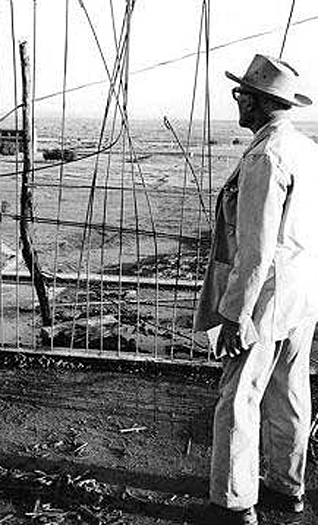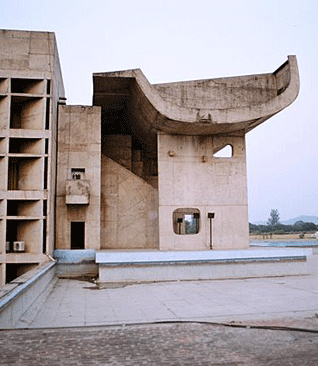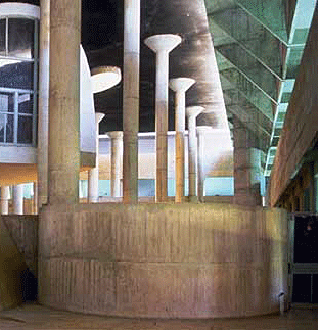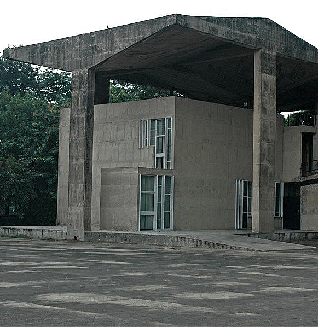
Above: Le Corbusier, overseeing the construction of Punjab's new capital city in 1955. Thumbnail image: Punjab's Palace of Justice.

Secretariat

Legislative
Assembly

Museum
Architecture
The Pearl of the Punjab
by JONATHAN GLANCEY
Le Corbusier had long dreamed of building an ideal city.
In the early 1920s, this most inventive and controversial of all 20th-century architects even suggested demolishing half of Paris to build a city of modern towers, set in an urban parkland.
As fate, and Indian independence, would have it, the Swiss-French genius eventually got his chance - on the blisteringly hot plains of the Punjab.
Today, the city he built there - Chandigarh, 250 km north of Delhi - is one of the world's most distinctive and beguiling places.
It is a city set around a vast artificial lake, composed of abstract 1950s civic buildings and public monuments that look like Picasso paintings made concrete. Based on a super-rational, Modern movement grid, it is European in spirit, yet owes nothing to the Raj. It has parks, bird life, flowers and sweet-smelling roses in abundance. Chandigarh is as intriguing as it is unlikely: a Corbusian dream realised far, far from Paris.
But Paris is now central to Chandigarh's future.
In 2006, Chandigarh officials submitted a bid to UNESCO's Paris-based headquarters to make the city a World Heritage Site, hoping to bring it status, international cash and conservation expertise, not to mention hordes of tourists. The dream has just taken a big step closer to reality, with a dossier of new arguments being sent to Paris this month, highlighting the many reasons why the city should be ranked alongside the Taj Mahal, the Acropolis, Old Havana and Stonehenge. An announcement could come as early as Spring.
Baking summers and freezing winters are not kind to concrete, and Le Corbusier's use of this cheap, readily available and easily worked material is one of the reasons Chandigarh still has its detractors. The architect is still thought of by some as the inspiration behind horrid, high-rise concrete estates worldwide.
Such critics have clearly never been to Chandigarh, where most of the buildings have just three storeys and are, in any case, outnumbered by trees.
Jawaharlal Nehru, the first prime minister of an independent India, wanted a modern city, a counterweight to British Indian tradition of the past two hundred years and a signal that India was off to a fresh start. Le Corbusier drew from the English Garden City movement and from the rigorous, right-angled urban planning precepts of France's CIAM, a kind of Modern thinktank.
At Chandigarh, these two unlikely bedfellows met. The result is a strangely glorious mix of romantic and rational planning: park upon park, trees in their thousands, roses and some of the most impressive of Le Corbusier's mesmeric works.
Indeed, the State Assembly building is one of the finest things he ever built anywhere. It is the focal point of Chandigarh: set in architectural conversation with two other major buildings, the Secretariat and the High Court, it is at once a seat of government and an abstract Modern artwork. Rising by the great artificial Lake Sukhna, the Assembly draws politicians and lucky visitors (you need to write ahead for permission to visit) into its great, tapestry-hung, forest-like spaces, and into its spectacular circular hall.
This man-made cavern is crowned with a vast concrete cupola. Like the other Le Corbusier buildings in Chandigarh, the Assembly has its flaws: the chamber's acoustics are far from ideal, and microphones are needed, even though members should be able to hear one another unaided in a space of this size. And the concrete here, and elsewhere, is in need of a good wash and brush-up.
And yet this, with its attendant buildings and monuments, is one of the most compulsive sights in urban India today. You stand in waves of overlapping plazas, each set about with buildings that look like nothing else. It's impossible - when so much in the world that's new looks and feels the same - not to be moved by such distinctive design.
Of the monuments, no one will want to miss Le Corbusier's enormous Open Hand. A giant construction of beaten iron that turns in the winds, it symbolises Chandigarh's motto: "Open to give, open to receive". British visitors will be drawn to the nearby Martyr's Memorial, commemorating those who died in the fight for Indian independence. A broken column symbolises the fall of the Raj.
The city is divided into 46 sectors, each including three-storey blocks of concrete apartments, shops and essential services. While each of the sectors is almost, if not quite, self-sufficient, Sector 17 is where the action is. This is the "heart" of the city, bustling with shops and offices and transformed over the decades into a properly colourful and eventful Indian city centre. Inevitably, this is also where you'll find Subway outlets and McDonald's.
Originally surrounded by a British-style green belt, Chandigarh has long been bursting its bounds. Designed for a population of up to 500,000, it is now home to double that or more. People are attracted by the city's standard of living: incomes are high, child mortality low. As well as the green spaces, there are museums and colleges in abundance, and new jobs in the IT sector.
But the city seems determined to adapt itself intelligently to new concerns without losing its special physical character. Not only is the historic core to be restored, but three new lakes are planned - softening the blow, perhaps, of plans for a new international airport. This is a green city and wants to remain so.
Chandigarh was an international effort to create a new kind of postcolonial city in India. Le Corbusier's major work was completed by 1955. Now, new generations of Indian architects have taken the project on, most showing respect towards a remarkable design.
Sure, Chandigarh sprawls.
And yet, if you came this way, and stood by the lake and gazed at its artful monuments and out across the treetops, you would, I'm sure, agree there is architectural sorcery at work here.
What's it like to live or work in a Le Corbusier building?
Ranjit Sehgal lives with his wife, Francesca, in the historic Anokha house, designed by Le Corbusier. With its curved white exterior, this is one of the most important "heritage" houses of Chandigarh.
My father lost everything in Partition. He was from Lahore. Chandigarh was, for many, a dream in the desert, a new beginning for the dispossessed in new India. This house was built by Le Corbusier's cousin, Pierre Jeanneret, also a distinguished architect, under Le Corbusier's guidance. Jeanneret lived next door, and said the curves were to remind him of my mother's beauty. The white structure on the front was, he joked, because my father had a big nose.
We love living here: it has always been our home, even when we lived abroad. My father made some alterations: he added a sitting room, and we have added servants' quarters, all in keeping with the style of the house. The planning laws are strict with a house such as this.
People are terribly proud of being from Chandigarh. They have been coming back from abroad to retire here. They have lived in cultured, ordered, clean societies and I think that reinforces the native pride, the desire to keep the city spotless.
Chandigarh was designed for its citizens. They say there are no poor here - what a joke. The poor do live among us, but we do not have the slums of Bombay.
What the city has, which is different to the rest of India, is a local government that is trying to get it right. They want to create the model environment. So people are fined for smoking in public and using a mobile phone while driving. There is a feeling that laws are made to be enforced.
Rajnish Wattas is the principal of The Chandigarh College of Architecture, designed by Le Corbusier.
Chandigarh is not an Indian city in the traditional sense: you know, bazaars, disorder, dust. It is modern, planned, but not romantic. There is no quaintness. Fifty years or so is nothing to stuff a soul into a city, but what looks prosaic now will look poetic in a hundred years.
Le Corbusier called concrete the molten rock of the 20th century. He sculpted the buildings. Working in a building designed by him is unlike working in any other. It is a sculptural space, lending itself to creativity.
There are flip sides, though. Concrete is harsh to look at, and Le Corbusier did not get the climate control right: in the summer, with seven months of searing heat, it gets very hot, and in the winter, it is very cold.
Anupam Gupta is a lawyer who works in the High Court, designed by Le Corbusier.
People in Bombay and Delhi used to consider us a village with no nightlife, too quiet - the capital of retired people. But today Chandigarh is vibrant, young, more outward-looking. It has retained its charm, thanks largely to Le Corbusier's foresight.
He designed it as a counterpoint to the industrial city: for him, the centre was where people lived. That is why we have parks and greenery - but no statues of people. Le Corbusier did not want any. He was a democrat. Nor did he want skyscrapers, so the tallest building is the Secretariat, just ten storeys.
Architecture shapes outlook. This court, with its curves and high roof, is trying to convey modernity. It is peaceful; I love working here. In Europe, court buildings are imposing, majestic structures. Here, too, we have to give an image of being a palace of justice - without being overbearing. It makes one think deeply about what we do as lawyers.
People say Chandigarh is not Indian enough, that it should reflect India. I don't know what they mean. Should it be closer to a village? I have lived here all my life and I like the fact that it's a modern city with an egalitarian outlook, free of past prejudices. Le Corbusier, in that sense, is my history. My parents live in Delhi. I cannot stand it for more than a couple of days - the noise, the sounds, the smells.
Sehar Mohan is a student at the College of Art, designed by Le Corbusier.
It is great to study in a place built by someone we study. The best thing about the college is that it's so green, with lots of light inside.
I think Le Corbusier's architecture has made Chandigarh more law-abiding. There are fewer crimes here than in Delhi, say. And people are on time, which is not the case in other cities in India. But the biggest difference for me is that Chandigarh is safe for women to walk at night. They are free here; the city is very woman-friendly. They work; they can choose their lifestyles. I like the pace of life.
Le Corbusier designed Chandigarh for people: there are cycle tracks for the poor and playgrounds for the children. The architecture is really neat and clean, with green space and buildings in balance. People from outside do not think it is India. These days we are seeing many people coming, looking for a job, and we are getting malls and companies, too. This might spoil the city.
[Courtesy: Guardian Unlimited]
Conversation about this article
1: Baljeet (Auckland, New Zealand), January 29, 2008, 4:22 AM.
Chandigarh is an awesome place. The reason I had enjoyed staying in India is because I had lived in Chandigarh, it is has become a part of me. This is the best city in the India.
2: Kuljeet Singh (Boston, U.S.A.), January 30, 2008, 7:22 PM.
Though built as the Capital of Punjab, Chandigarh is currently a union territory and not technically within the State of Punjab. This powerhouse was stripped away from Punjab in a deliberate move to stifle the economy of the predominantly Sikh modern-day Punjab. What's new!
3: Satvir Kaur (Boston, U.S.A.), February 01, 2008, 10:50 AM.
Another 20 villages and the accompanying territory stolen from Punjab and never given back. Yeah! India can be proud!
4: Prabhu Singh Khalsa (Española, New Mexico, U.S.A.), February 07, 2008, 5:59 PM.
I don't care much for Chandigarh either. When I was there I thought, "Why am I here, I could be in Amritsar or Anandpur Sahib?" I didn't even visit a Gurdwara there, they were scarcer than elsewhere in Punjab. As a Sikh, it didn't offer me anything that any other city didn't have.
5: Jessie Kaur (Toronto, Canada), February 13, 2008, 9:35 PM.
The modernist architecture of Chandigarh is unlike anything else in Punjab, as far as I know. On its own, it is quite spectacular. Unfortunately, the city has not been maintained in a way that is consistent with this style of architecture and the way in which the entire grid was laid out. For this reason, the beautiful gems that lie within it go unnoticed and unappreciated. The museum in Chandigarh is fantastic and is well worth visiting. I was pleasantly surprised with the quality of historical artifacts from different periods of history, including modern and post-modern art, and an entire building dedicated to Chandigarh's history pre-partition, during its planning period, and up to the present day. No one who visits the museum will be disappointed!
6: Udom Srichawla (Bangkok, Thailand), July 19, 2008, 12:04 PM.
Punjab's Chandigarh is the most beautiful city in India. I was there from 1967 to 1972 in the Govt. College for Men in Sector 11 and Punjab Universty Hostel no 1.
7: Palvinder Singh Deol (Chandigarh, Punjab), June 13, 2014, 3:20 PM.
I currently live in Chandigarh. An awesome feeling ... beautiful infrastructure. I just love it.


